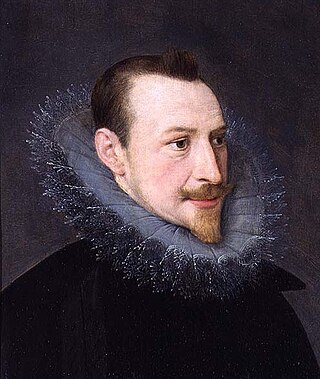
Edmund Spenser was an English poet best known for The Faerie Queene, an epic poem and fantastical allegory celebrating the Tudor dynasty and Elizabeth I. He is recognized as one of the premier craftsmen of nascent Modern English verse, and he is considered one of the great poets in the English language.
The term sonnet refers to a fixed verse poetic form, traditionally consisting of fourteen lines adhering to a set rhyming scheme. It derives from the Italian word sonetto. Originating in 13th-century Sicily, the sonnet was in time taken up in many European-language areas, mainly to express romantic love at first, although eventually any subject was considered acceptable. Many formal variations were also introduced, including abandonment of the quatorzain limit – and even of rhyme altogether in modern times.
Richard Barnfield was an English poet. His relationship with William Shakespeare has long made him interesting to scholars. It has been suggested that he was the "rival poet" mentioned in Shakespeare's sonnets.

Michael Drayton was an English poet who came to prominence in the Elizabethan era, continuing to write through the reign of James I and into the reign of Charles I. Many of his works consisted of historical poetry. He was also the first English-language author to write odes in the style of Horace. He died on 23 December 1631 in London.
This article is a summary of the literary events and publications of 1595.

Elizabethan literature refers to bodies of work produced during the reign of Queen Elizabeth I (1558–1603), and is one of the most splendid ages of English literature. In addition to drama and the theatre, it saw a flowering of poetry, with new forms like the sonnet, the Spenserian stanza, and dramatic blank verse, as well as prose, including historical chronicles, pamphlets, and the first English novels. Major writers include William Shakespeare, Edmund Spenser, Christopher Marlowe, Richard Hooker, Ben Jonson, Philip Sidney and Thomas Kyd.

"A Lover's Complaint" is a narrative poem written by William Shakespeare, and published as part of the 1609 quarto of Shakespeare's Sonnets. It was published by Thomas Thorpe.
Thomas Watson (1555–1592) was an English poet and translator, and the pioneer of the English madrigal. His lyrics aside, he wrote largely in Latin, also being the first to translate Sophocles's Antigone from Greek. His incorporation of Italianate forms into English lyric verse influenced a generation of English writers, including Shakespeare, who was referred to in 1595 by William Covell as "Watson's heyre" (heir). He wrote both English and Latin compositions, and was particularly admired for the Latin. His unusual 18-line sonnets were influential, although the form was not generally taken up.

Sonnet 153 is a sonnet by William Shakespeare.

Sonnet 54 is one of 154 sonnets published in 1609 by the English playwright and poet William Shakespeare. It is considered one of the Fair Youth sequence. This sonnet is a continuation of the theme of inner substance versus outward show by noting the distinction between roses and canker blooms; only roses can preserve their inner essence by being distilled into perfume. The young man's essence or substance can be preserved by verse.

Il Canzoniere, also known as the Rime Sparse, but originally titled Rerum vulgarium fragmenta, is a collection of poems by the Italian humanist, poet, and writer Petrarch.
William Smith (15??-16??) was an English sonneteer, poet, and friend of Edmund Spenser. He participated in The Phoenix Nest (1593), England's Helicon (1600) and published a sonnet sequence Chloris or The Complaint of the passionate despised Shepheard in 1596.

Amoretti is a sonnet cycle written by Edmund Spenser in the 16th century. The cycle describes his courtship and eventual marriage to Elizabeth Boyle.

The sonnets of Petrarch and Shakespeare represent, in the history of this major poetic form, the two most significant developments in terms of technical consolidation—by renovating the inherited material—and artistic expressiveness—by covering a wide range of subjects in an equally wide range of tones. Both writers cemented the sonnet's enduring appeal by demonstrating its flexibility and lyrical potency through the exceptional quality of their poems.
Thomas Creede was a printer of the Elizabethan and Jacobean eras, rated as "one of the best of his time." Based in London, he conducted his business under the sign of the Catherine Wheel in Thames Street from 1593 to 1600, and under the sign of the Eagle and Child in the Old Exchange from 1600 to 1617. Creede is best known for printing editions of works in English Renaissance drama, especially for ten editions of six Shakespearean plays and three works in the Shakespeare Apocrypha.

William Ponsonby was a prominent London publisher of the Elizabethan era. Active in the 1577–1603 period, Ponsonby published the works of Edmund Spenser, Sir Philip Sidney, and other members of the Sidney circle; he has been called "the leading literary publisher of Elizabethan times."
Mathew Roydon was an English poet associated with the School of Night group of poets and writers.
Lodowick Bryskett, was a poet, translator, diplomat and Irish official. He served as Special Ambassador from England to Tuscany in 1600-01.

Epithalamion is an ode written by Edmund Spenser to his bride, Elizabeth Boyle, on their wedding day in 1594. It was first published in 1595 in London by William Ponsonby as part of a volume entitled Amoretti and Epithalamion. Written not long since by Edmunde Spenser. The volume included the sequence of 89 sonnets (Amoretti), along with a series of short poems called Anacreontics and the Epithalamion, a public poetic celebration of marriage. Only six complete copies of this first edition remain today, including one at the Folger Shakespeare Library and one at the Bodleian Library.

Kilcolman Castle is a tower house located in County Cork, Ireland. It was formerly the residence of the poet Edmund Spenser.